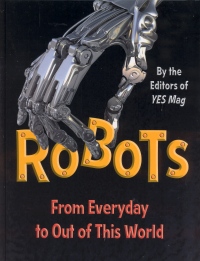The editors of YES Mag are back with their fourth non-fiction title for young readers. And like their previous books – which include The International Space Station and Science Detectives – Robots is a lively read that mixes history, technical information, and fun facts. The book takes an intriguing subject and manages to be both comprehensive and entertaining.
Robots begins with a definition of what a robot is – namely, a machine with moveable parts that can be programmed and reprogrammed to do a task. Most young readers have become so accustomed to robotics in daily life that they take them for granted, and don’t realize that these mechanical aides have had a long and complicated development process.
The book’s early pages brilliantly illustrate this journey, showing robotic concepts through the ages – ranging from a “robot-knight,” run by pulleys, wooden disks, and gears, that was designed by Leonardo da Vinci in the late 1400s, to “Shakey,” a late-1960s mobile robot from the Stanford Research Institute in California that could locate objects and avoid obstacles in a room. That sets the stage for detailed descriptions of how modern robots work, the kinds of jobs they do, how they are put together, and, perhaps most importantly, how “roboticists” are making huge strides in constructing lifelike robots that mirror human movement and activity – to a degree that can seem downright C3PO-esque and a little scary.
The book concludes with chapters on the future of robots, including one section on a scientist who implanted silicon chips in his arm that allow his movements to be monitored by computers. (It’s no accident that this spread is entitled “Cool or Creepy?”) Also included are a concise glossary of terms and a comprehensive index.
Robots will be a satisfying read for many youngsters, and will be especially enjoyable for those who like their technology served with a healthy dose of context – why we need robots, where they came from, who’s responsible for making them what they are today, and, above all, what they’re likely to be able to do in the near future.






